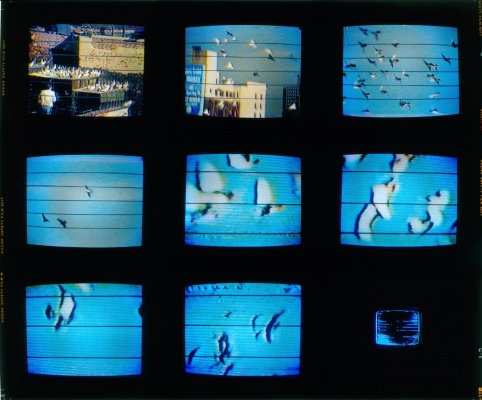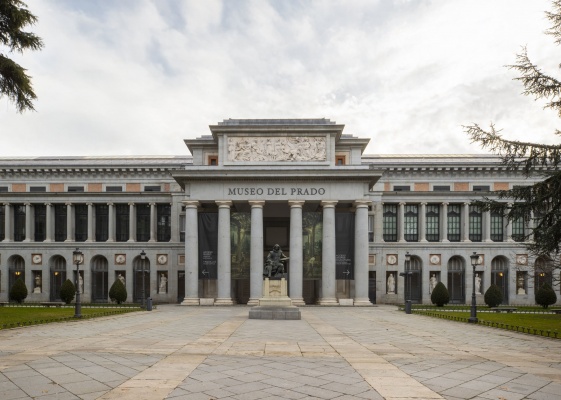Descripción de la Exposición
For a brief period in 2018, one of Buenos Aires’ eighty-year-old fishing piers ended in a glass-paned revolving door: a portal to the horizon, eight hundred meters from the shore. The revolving door was part of an installation The Perspective of Absence, Argentinian artist Eduardo Basualdo’s contribution to Art Basel Cities, a week-long exhibition that took place across Buenos Aires. I imagine how precarious visitors must have felt with the doors’ revolving invitation to be swept into the waves beyond, into the horizon and off the world’s edge. Of course, the fear is only as real as Basualdo’s constructed fiction. Still, standing on the coast of a continent inspires a sublime sense of one’s smallness. Within such fictional spaces, Basualdo has said, “Fragility…is a very attractive state from which to think and feel.”
Working in a wide range of materials, from steel and paper to mirrors and textiles, Basualdo creates architectural structures and mysterious, uncanny objects. His works are often large-scale installations that immerse—and sometimes overwhelm—viewers. Many of Basualdo’s recent works have been crafted from Cinefoil, a matte-black aluminum foil used in theatre productions to absorb light, which he shapes into immense organic forms that resemble volcanic boulders, scorched earth, or rippling black holes. They’re landed meteorites still eclipsing light and space. They’re archeological excavations of curled, fossilized bodies captured under hardened ash. They swallow light into vast tracts of darkness while also creating pinprick constellations where the foil has been worn down and punctured. They appear to be dense and immoveable but are actually lightweight and flimsy when handled. They are imposing and alien.
The origins of Cinefoil point to the broader influence of theatre for Basualdo. Like in a theatre’s black box, where audiences may be at once lost in the story before them and acutely aware of their bodies (don’t cough; don’t fidget), Basualdo heightens the viewer’s awareness of their own physical presence while their mind is carried to alternate realities. In another ongoing body of work, Basualdo fabricates barriers that emulate the tall steel-bar gates typically found in prison cells. They seem impenetrable from a distance, but as one approaches, they see that the spaces between the bars is in fact wide enough to accommodate passage. In his world of easily permeable gates, Basualdo reveals the absurdity of institutional structures designed to restrain. While barriers and fences may posture as inherent features of a landscape, they are exposed as arbitrary acts of control when they are physically overcome. The limits have limitations.
Basualdo’s work considers these limitations: of experiencing life through only one body; of the conditions architecture places on our habits and movements; and of human understandings of existence. The works remind me of a game I used to play as a child where I would stare into a mirror until my face morphed into something strange and unfamiliar, like how repeating the same word over and over eventually renders it unrecognizable. When even my appearance stopped feeling like my own, nothing in the world felt like a given; everything was malleable and delicate—a terrifying and amazing realization. It’s the same feeling I get from Basualdo’s fictional worlds. “If you’re not allowed to get to the end,” he says, “you imagine the end.” – Josi Smit
Eduardo Basualdo (b.1977) is a multimedia artist whose work is informed by his training as an actor and puppeteer. In the 2010 he participated in the Guillermo Kuitca scholarship at the Universidad Torcuato Di Tella. Basualdo’s works have been presented in the Biennale de Lyon (2011); the Biennale de Montevideo (2012); the Gwangju Biennale (2014); ‘All the World’s Futures’ at the 56th Biennale di Venezia (2015); and the 12th Bienal de La Habana (2015). Selected solo presentations include ‘Nervio’ at the Musée Départemental d’Art Contemporain de Rochechouart, Limoges (2013); ‘The End of Ending’ at the Hirshhorn Museum and Sculpture Garden, Washington, D.C., 2016; the Museu Brasileiro de Escultura e Ecologia, São Paulo (2017); and ‘La Cabeza de Goliat’ at La Usina del Arte, Buenos Aires (2018). Since 2003 Basualdo has been part of Provisorio/Permanente, a four-person group with which he presents theatrical installations.

Exposición. 08 may de 2025 - 14 sep de 2025 / MNAC - Museu Nacional d'Art de Catalunya / Barcelona, España

Formación. 30 oct de 2025 - 11 jun de 2026 / Museo Nacional del Prado / Madrid, España